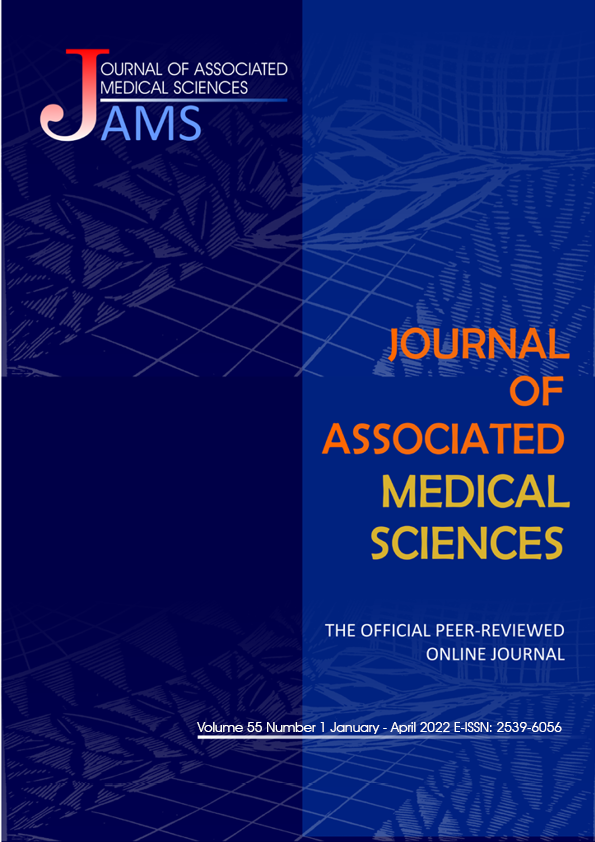The local diagnostic reference levels for breast screening using digital mammography at Songklanagarind Hospital
Main Article Content
Abstract
Introduction: This work aimed to determine local diagnostic reference levels (local DRLs) for screening mammography at Songklanagarind Hospital on digital mammography.
Materials and methods: Retrospective data of screening mammography were collected from 400 patients from Songklanagarind Hospital, 200 patients from Tanyawej Breast Center and 200 patients from Premium Diagnostic Imaging Center. The patients were women aged between 40-75 years old with compressed breast thickness between 41-65 mm. and undertaken screening mammogram during 1st January 2019 – 31st October 2020. Patient data and exposure parameters collected were as follows: average glandular dose (AGD), entrance surface air kerma (ESAK), compressed breast thickness (CBT), compression force (CF), peak kilovoltage (kVp), tube current-time (mAs), target and filter (W/Rh, W/Al), and patient age.
Results: The result showed that the average glandular dose of FFDM (2D mode) and DBT (3D mode) for compressed breast thickness 41-65 mm were 1.41±0.43 and 1.68±0.39 mGy, respectively and the 75th percentile of FFDM (2D mode) and DBT (3D mode) were 1.65 mGy and 1.89 mGy, respectively. The average ESAK were 4.93±1.96 mGy in FFDM (2D mode) and 5.31±1.55 mGy in DBT (3D mode), respectively. The 75th percentile of ESAK in FFDM (2D mode) and DBT (3D mode) were 6.03 and 6.17 mGy, respectively. There were 24.88 % and 24.63% received the average glandular dose over the 75th percentile in FFDM (2D mode) and DBT (3D mode).
Conclusion: Local Diagnostic Reference Levels for FFDM (2D mode) and DBT (3D mode) at Songklanagarind Hospital were 1.65 mGy and 1.89 mGy. The Local DRLs in our study was safe and lower than the standard reference levels reported by the International Atomic Energy Agency at 3 mGy/view.
Article Details

This work is licensed under a Creative Commons Attribution-NonCommercial-NoDerivatives 4.0 International License.
Personal views expressed by the contributors in their articles are not necessarily those of the Journal of Associated Medical Sciences, Faculty of Associated Medical Sciences, Chiang Mai University.
References
Virani S, Bilheem S, Chansaard W, Chitapanarux I, Daoprasert K, Khuanchana S, et al. National and Subnational Population-Based Incidence of Cancer in Thailand: Assessing Cancers with the Highest Burdens. Cancers. 2017; 9(12): 108.
Internationale Atomenergie-Organisation, Internationale Atomenergie-Organisation, editors. Dosimetry in diagnostic radiology: an international code of practice. Vienna: International Atomic Energy Agency; 2007. 359 p. (Technical reports series).
Nguyen JV, Williams MB, Patrie JT, Harvey JA. Do women with dense breasts have higher radiation dose during screening mammography. Breast J. 2018; 24(1): 35-40.
Perry N, Europäische Kommission, editors. European guidelines for quality assurance in breast cancer screening and diagnosis. 4th ed. Luxembourg: Office for Official Publ. of the Europ. Communities; 2006. 416 p.
Suleiman ME, McEntee MF, Cartwright L, Diffey J, Brennan PC. Diagnostic reference levels for digital mammography in New South Wales. J Med Imaging Radiat Oncol. 2017; 61(1): 48-57.
MEDICAL PHYSICS INTERNATIONAL. 2020; 3.
Ritlumlert N, Tangruangkiat S, Kawvised S, Pairodsantikul P, Pairodsantikul P, Vidhyarkorn S. Assessment of Average Glandular Dose Received in Full-field Digital Mammography and Digital Breast Tomosynthesis. J Health Sci Med Res. 2020; 38(2): 115-23.
Kawaguchi A, Matsunaga Y, Otsuka T, Suzuki S. Patient investigation of average glandular dose and incident air kerma for digital mammography. Radiol Phys Technol. 2014;7(1): 102-8.


